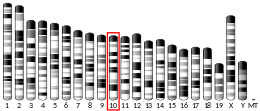PDSS2
Decaprenyl-diphosphate synthase subunit 2 (PDSS2) is a protein that in humans is encoded by the PDSS2 gene.[5]
Function
The protein encoded by this gene is an enzyme that synthesizes the prenyl side-chain of coenzyme Q, or ubiquinone, one of the key elements in the respiratory chain. The gene product catalyzes the formation of all trans-polyprenyl pyrophosphates from isopentyl diphosphate in the assembly of polyisoprenoid side chains, the first step in coenzyme Q biosynthesis.[5]
Clinical significance
It may be associated with Coenzyme Q10 deficiency.[6]
gollark: But they need SE rep for it.
gollark: 106.0004.
gollark: How quickly can you get 50 reputation units?
gollark: I knew it. They're secretly trying to sabotage the country's esolangs program.
gollark: CCP? Is this person a Chinese Communist Party member?
See also
References
- GRCh38: Ensembl release 89: ENSG00000164494 - Ensembl, May 2017
- GRCm38: Ensembl release 89: ENSMUSG00000038240 - Ensembl, May 2017
- "Human PubMed Reference:". National Center for Biotechnology Information, U.S. National Library of Medicine.
- "Mouse PubMed Reference:". National Center for Biotechnology Information, U.S. National Library of Medicine.
- "Entrez Gene: prenyl (decaprenyl) diphosphate synthase".
- Online Mendelian Inheritance in Man (OMIM): 607426
Further reading
- Talmud PJ, Drenos F, Shah S, et al. (2009). "Gene-centric association signals for lipids and apolipoproteins identified via the HumanCVD BeadChip". Am. J. Hum. Genet. 85 (5): 628–42. doi:10.1016/j.ajhg.2009.10.014. PMC 2775832. PMID 19913121.
- Mungall AJ, Palmer SA, Sims SK, et al. (2003). "The DNA sequence and analysis of human chromosome 6". Nature. 425 (6960): 805–11. doi:10.1038/nature02055. PMID 14574404.
- Diomedi-Camassei F, Di Giandomenico S, Santorelli FM, et al. (2007). "COQ2 nephropathy: a newly described inherited mitochondriopathy with primary renal involvement". J. Am. Soc. Nephrol. 18 (10): 2773–80. doi:10.1681/ASN.2006080833. PMID 17855635.
- Gerhard DS, Wagner L, Feingold EA, et al. (2004). "The status, quality, and expansion of the NIH full-length cDNA project: the Mammalian Gene Collection (MGC)". Genome Res. 14 (10B): 2121–7. doi:10.1101/gr.2596504. PMC 528928. PMID 15489334.
- Maruyama K, Sugano S (1994). "Oligo-capping: a simple method to replace the cap structure of eukaryotic mRNAs with oligoribonucleotides". Gene. 138 (1–2): 171–4. doi:10.1016/0378-1119(94)90802-8. PMID 8125298.
- Cui TZ, Kaino T, Kawamukai M (2010). "A subunit of decaprenyl diphosphate synthase stabilizes octaprenyl diphosphate synthase in Escherichia coli by forming a high-molecular weight complex". FEBS Lett. 584 (4): 652–6. doi:10.1016/j.febslet.2009.12.029. PMID 20051244.
- Strausberg RL, Feingold EA, Grouse LH, et al. (2002). "Generation and initial analysis of more than 15,000 full-length human and mouse cDNA sequences". Proc. Natl. Acad. Sci. U.S.A. 99 (26): 16899–903. doi:10.1073/pnas.242603899. PMC 139241. PMID 12477932.
- Saiki R, Nagata A, Kainou T, et al. (2005). "Characterization of solanesyl and decaprenyl diphosphate synthases in mice and humans". FEBS J. 272 (21): 5606–22. doi:10.1111/j.1742-4658.2005.04956.x. PMID 16262699.
- Machuca E, Benoit G, Nevo F, et al. (2010). "Genotype-phenotype correlations in non-Finnish congenital nephrotic syndrome". J. Am. Soc. Nephrol. 21 (7): 1209–17. doi:10.1681/ASN.2009121309. PMC 3152225. PMID 20507940.
- Chen P, Zhao SH, Chu YL, et al. (2009). "Anticancer activity of PDSS2, prenyl diphosphate synthase, subunit 2, in gastric cancer tissue and the SGC7901 cell line". Anticancer Drugs. 20 (2): 141–8. doi:10.1097/CAD.0b013e32832016a9. PMID 19209031.
- Hendrickson SL, Lautenberger JA, Chinn LW, et al. (2010). "Genetic variants in nuclear-encoded mitochondrial genes influence AIDS progression". PLOS ONE. 5 (9): e12862. doi:10.1371/journal.pone.0012862. PMC 2943476. PMID 20877624.
- Suzuki Y, Yoshitomo-Nakagawa K, Maruyama K, et al. (1997). "Construction and characterization of a full length-enriched and a 5'-end-enriched cDNA library". Gene. 200 (1–2): 149–56. doi:10.1016/S0378-1119(97)00411-3. PMID 9373149.
- Vieira AR, McHenry TG, Daack-Hirsch S, et al. (2008). "Candidate gene/loci studies in cleft lip/palate and dental anomalies finds novel susceptibility genes for clefts". Genet. Med. 10 (9): 668–74. doi:10.1097/GIM.0b013e3181833793. PMC 2734954. PMID 18978678.
- Bailey SD, Xie C, Do R, et al. (2010). "Variation at the NFATC2 locus increases the risk of thiazolidinedione-induced edema in the Diabetes REduction Assessment with ramipril and rosiglitazone Medication (DREAM) study". Diabetes Care. 33 (10): 2250–3. doi:10.2337/dc10-0452. PMC 2945168. PMID 20628086.
This article incorporates text from the United States National Library of Medicine, which is in the public domain.
This article is issued from Wikipedia. The text is licensed under Creative Commons - Attribution - Sharealike. Additional terms may apply for the media files.



